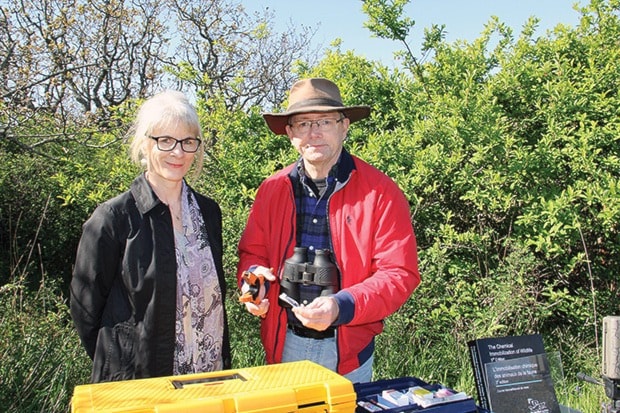A new citizen group hopes to start trapping and tagging deer in Oak Bay by fall.
Urban Wildlife Stewardship Society launched the Oak Bay Deer Plan, a pilot program with the objective to limit birth of fawns using immuno-contraceptives.
“Governments at all levels do have a massive job and we appreciate what they do, yet they’re always limited by budgets, by staff… and the experience and training of their staff,” said Oak Bay resident Bryan Gates, president of the new Urban Wildlife Stewardship Society. “They need technical help in many cases, and this society is formed for that purpose.
“We can provide alternatives … We want to offer an incredible stewardship and management program for deer in Oak Bay,” he said. “There are other programs that the society, we think, can undertake in the future but today it’s really deer we want to concentrate on.”
The new citizen group officially launched Tuesday in its bid for a non-lethal and science-based approach to managing the deer population in Oak Bay. The group, which has secured start-up funding, is comprised of deer scientists, educators and managers with extensive senior public service experience.
“This is an opportunity we believe for Victoria to show leadership and to be the leaders in providing an alternative to being stewards for wildlife in urban areas,” said Oak Bay resident Kristy Kilpatrick, vice-president of Urban Wildlife Stewardship Society. “We’re really proud to try and start this process.”
The society will apply to Health Canada for a permit to use Spay-Vac on black-tailed deer in the district and apply to the province to allow for capture and inoculation.
“We are partnering with the University of Victoria scientists and graduate students,” said Dr. Rick Page, chief scientist for Deer Plan Oak Bay. “What we hope to achieve is to demonstrate to the governments that as a citizens-based group we can do what we wanted them to do but seem to have been incapable of doing in terms of managing a deer population in a humane and sensitive way.”
The process would include clover traps with an adjacent motion-activated camera.
“We can set our traps during the day … we expect our biologist to be there within a half hour,” said Page.
All animals captured would be tagged.
“One of the reasons to do that is the federal government requires us to identify that it’s been treated experimentally – and the ear tags will say ‘do not eat’ – even though there is no known hazard.”
The other advantage is to track and identify deer, he said, which encourages citizen engagement as they can identify individual deer.
A tranquilizer would be available, only if necessary, and trapped females would be given the Spay-Vac, which prevents a doe from conceiving for five to seven years, Page said.
The project would start in the fall, with the expectation that Health Canada approval – which Page feels could be the lengthier process – could be in place by August. Fall is a good time, he said, as food is more scarce while does require more of it as they are still providing milk for fawns.
“The lethal cull that occurred in February and March was indiscriminate,” Kilpatrick said.
“With the UWSS program, any bucks that are captured will be tagged and released, allowing us to track their migratory patterns. Our target is not just 25 deer, it’s 25 female deer, which will make the project far more effective, both in terms of reducing and stabilizing the deer population, and cost.”
Oak Bay faced major criticism over the cull completed last month that saw 11 deer killed and meat distributed for First Nations use.
“It’s certainly something that’s welcome and it’s been welcome all through this process,” said Oak Bay Mayor Nils Jensen. “This is a research project and we didn’t want so much a research project as a deer management project.”
He warned of hurdles the society must cross.
“At the present time the information we’ve had from the B.C. wildlife veterinarian is the serum being used is not being manufactured. It will be a significant project because you would have to use clover traps to capture 70 to 90 per cent of the does for success.”
While the Oak Bay Deer Plan campaign is underway, UWSS sees future implications regionally and provincially if it’s a success.
“Our goal right now is to administer a humane, effective and non-lethal population control program for deer initially in Oak Bay and perhaps to expand in the region,” said Gates.
In the meantime, other essentials in deer management, such as signage on high deer-car collision roads and public education, are also a priority for the society.
“We believe we can help shift the conversation to those other mitigation projects,” Kilpatrick said. “There shouldn’t ever be a need for another lethal cull.”
As for the damage deer inflict on local gardens, Gates said, “fencing really is the only answer other than total annihilation.”
“Controlling population levels is our objective.”
cvanreeuwyk@oakbaynews.com
